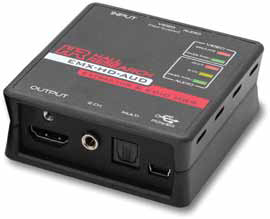New Tricks of the Trade in Converters and Scalers

Crestron DigitalMedia provides the digital backbone for the conference center at the Revel resort in Atlantic City, NJ. The meeting rooms needed to be able to handle any analog or digital device, whether it’s a laptop with HDMI, DVI, or DisplayPort outputs, a Blu-ray Disc player, or some other device, including Apple devices, which Crestron easily distributes.With video converters available on Amazon for under $35 it’s easy to imagine that AV system designers and integrators are under considerable pressure to maintain margins and market share. Quite the contrary: with the “analog sunset”— in the wider sense, not just pertaining to Bluray Disc players—upon us, a bewildering array of formats and copy protection schemes to deal with, and 4K video coming over the horizon, AV professionals are sitting in the catbird seat.
“Margins are eroding but the true billable value is and will always be in integration,” commented Justin Kennington, technology manager of digital media at Crestron. “The ability to design a robust solution that integrates AV on the network, with other services such as IT, HVAC, lighting, and security, remains a profitable business. Scaling is part of that integration that adds value and will continue to drive profitability.”
A.J. Shelat, vice president of sales at Hall Research, which makes video distribution, switching, scaling, conversion, and control systems, acknowledged that every AV equipment manufacturer has seen its product portfolio affected by commoditization. But, he noted, it’s not always apples to apples.
“One of the things we’ve noticed is that there are a lot of me-too products, but they’re consumer products, not professional grade. They don’t necessarily carry the same robust set of features and capabilities.”
Certainly someone could pick up an inexpensive display at Costco, but getting that display to work correctly in a system could be quite another matter. “Somebody is going to want to bring in some legacy equipment, and you’ve got the whole analog sunset taking place,” observed Shelat.

The Hall Research EMX-HD-AUD resolves many system level HDMI signal-chain issues by acting as an intelligent intermediary allowing incompatible components to function properly.Entertainment content creators have lobbied successfully to restrict analog video outputs on Blu-ray players to prevent circumvention of HDCP copy protection. Further, some of the world’s largest computer makers have announced that they are ending support of VGA, beginning this year.
“Integrating those legacy pieces of hardware that are professional grade and are expensive into a newer display that is not so expensive or very inexpensive makes a pretty big difference,” said Shelat. “Being able to pull all that together and provide an optimized output that the display can take and make look good takes a little bit of extra work.”
A daily selection of the top stories for AV integrators, resellers and consultants. Sign up below.
Then, of course, there are the issues associated with HDMI systems, including not only the management and handling of HDCP but also EDID throughout a system. EDID may have been intended to streamline the connection of devices to displays, but if a component has no EDID implementation, there will simply be no image.
“HDMI is actually quite useless as a commercial format. I think we’re finally going to have a product with an HDMI input, but we still have to tell everybody that the odds you’re going to be able to use it are pretty low,” reported Doug Engstrom, vice president of communications and technical services at Contemporary Research. “It’s not going to work for 90 percent of your sources, but here it is.”
As an industry, he continued, “In commercial applications we’re spending a lot of money trying to fake getting HDMI from point A to point B. We’re basically distributing HDMI over Cat-5 twisted-pair systems by cheating. We’re very often converting HDMI, Thunderbolt, and all the other standards to analog or stripping away the content protection— because the content isn’t protected in the first place. Nothing is being copied and nothing is being abused in a commercial installation, so they’re not breaking any laws.”

Contemporary Research focuses on a workflow that keeps an AV expert in the equation on projects like Russell Investments in Seattle, WA (above).Contemporary Research focuses on the wireless distribution of HD, SDI , and digital signage content, a workflow that is not readily purchased from an online catalog. “That usually puts an expert in the middle of that equation; that’s our strategy,” said Engstrom.
“In one sense that keeps the consumer out of it, because they have no hope to do what an Extron, AMX, or Crestron system can do in terms of media distribution.”
Indeed, Crestron is already getting out ahead of the next jump in technology, to 4K picture resolution. Scalers were integral to a system in the past, when different displays had different resolutions, observed Kennington. With virtually every display now supporting 1080p there tends to be less need for scaling. But 4K complicates the situation.
“With 4K on the horizon, we will need to manage and distribute these higher resolutions. The ability to scale 1080p to 4K can be challenging, and will play a major role in how systems are designed and which products manufacturers and integrators will recommend,” he said.
Steve Harvey (psnpost@nbmedia.com) has been west coast editor for Pro Sound News since 2000 and also contributes to TV Technology and Pro Audio Review. He has 30 years of hands-on experience with a wide range of audio production technologies.
